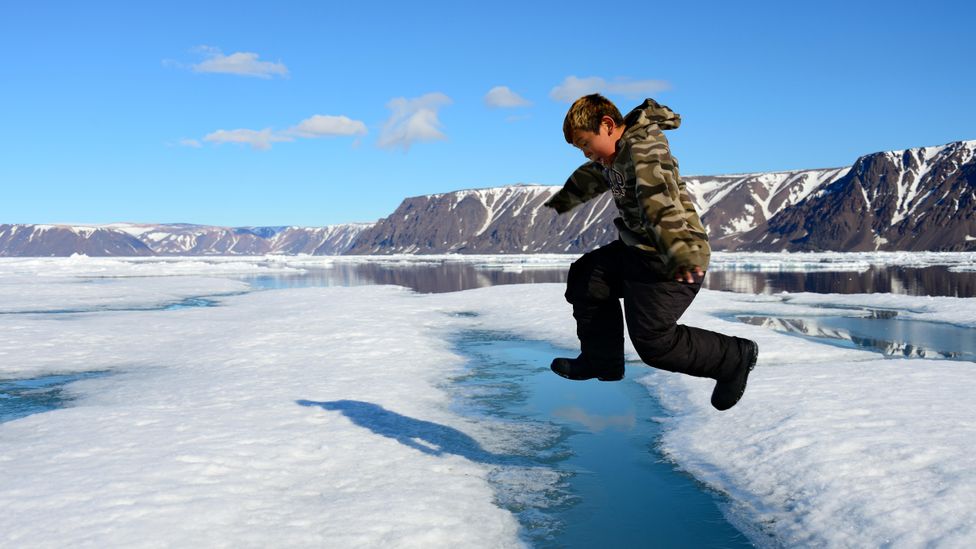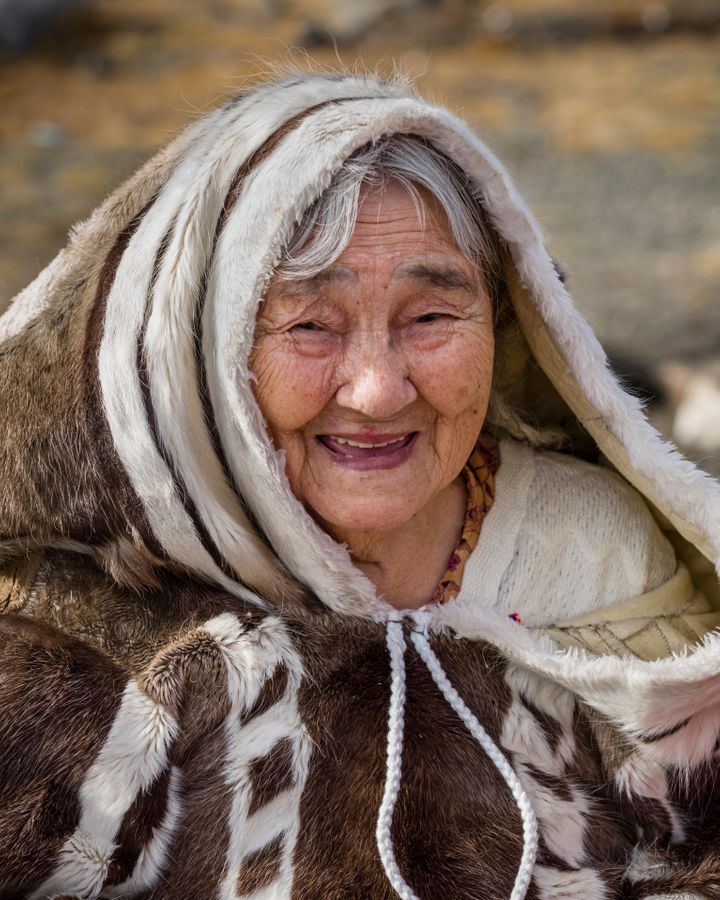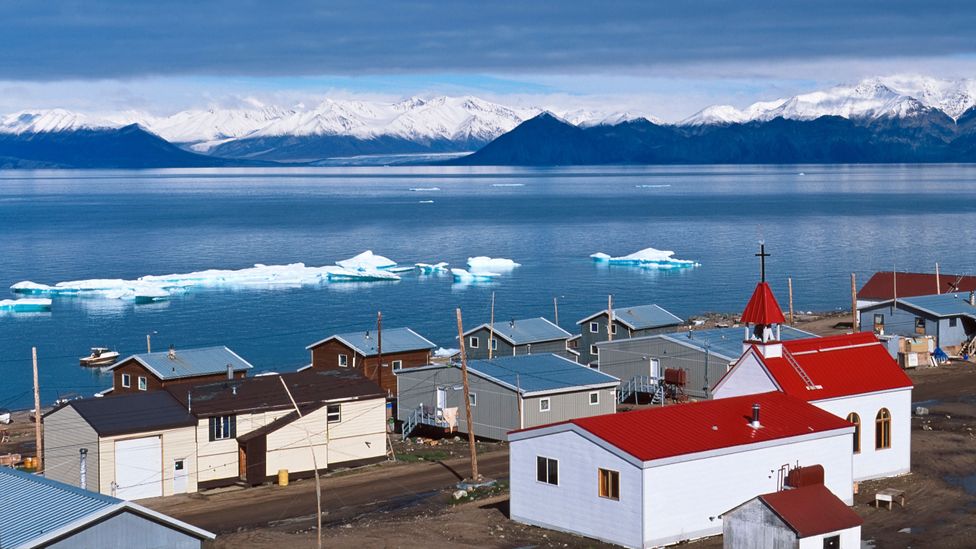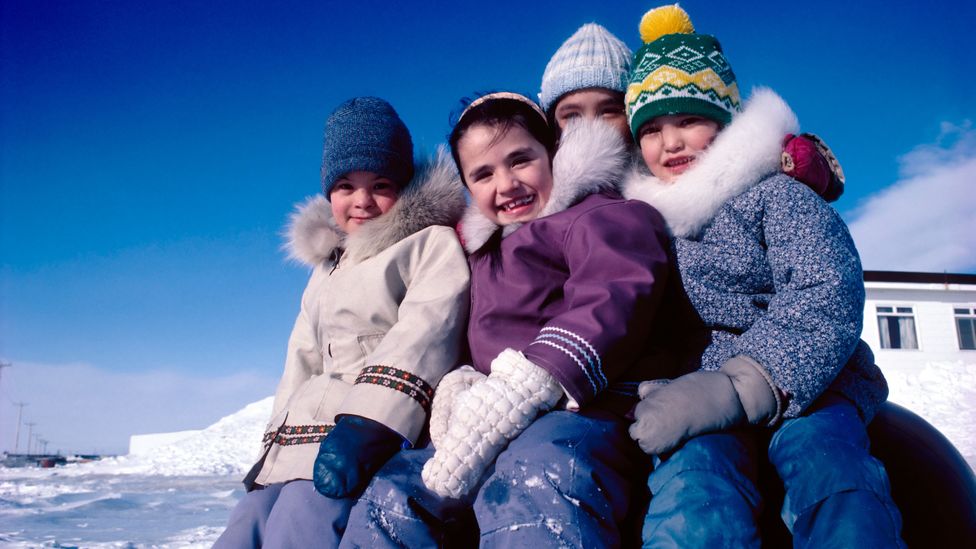
By Chris Baraniuk
BBC
11th October 2021
The Inuit are famous for their ability to survive extreme conditions, having inhabited the Arctic for millennia. But as the ice recedes, this hard-earned knowledge is being lost.
About 1,600 people live in the village of Pond Inlet, or Mittimatalik as it is known in the Inuit language Inuktitut. It is a community huddled between mountains, on a northern shore of Baffin Island, Canada – a place further north than the northernmost tip of mainland Norway. In winter, temperatures drop to an average of -35C (-31F), though they have been known to dip below -50C (-58F).
It's not the sort of place some people would immediately associate with "global warming". And yet, climate change is reshaping this part of the world dramatically – and impacting the people who live there.
"Everything we do involves the ocean and sea ice, which is highly affected by climate change," says Natasha Simonee, a member of the Inuit community in Pond Inlet.
Diminishing ice, warmer winters and changes to weather patterns are not just background noise for people like Simonee. These things have the potential to alter her whole way of life. She explains how elders in her community have grown reluctant to share traditional methods for predicting the weather, since the climate has changed so much. "They question whether it's accurate," she explains. "That kind of stuff is not necessarily practised and passed on anymore."
The Arctic, Earth's northern polar region, is warming about twice as fast as the rest of the world – and is home to four million people who are experiencing a particularly rapid and disruptive form of climate change. Among these Arctic residents are many indigenous groups, including Inuit, Saami and Chukchi people, to name a few.
You might also like:
What will an ice-free Arctic look like?
The daring plan to save the Arctic ice with glass
The icy camp where polar bears roam
There are many explanations for the accelerated rate of change in the Arctic, such as how the loss of white, reflective ice causes increasing amounts of thermal energy to be absorbed in this part of the world.
Simonee explains how thinning sea ice and slushy rivers make travelling across land using traditional methods more dangerous for people in her community. The skills involved for safe navigation, tracking and hunting are still passed on – but opportunities to do these things are increasingly threatened. Ancient traditions and unique forms of knowledge-sharing are at risk.
This includes time-honoured practices that few outside the Arctic have heard of. Alex Whiting – who is not Inuit but has lived in the Arctic for around 30 years – lives in the town of Kotzebue, or Qikiqtaġruk, in Alaska. Whiting explains that the traditional practice of burying fish in the ground and leaving it there to ferment, which extends the life of the foodstuff, is harder to do now than it once was. The technique relies on reliably cold temperatures throughout the winter.

As certain Arctic traditions are lost, the words that were used to describe them are disappearing too (Credit: Alamy)
"Those kind of skills are already becoming really tough to pass on to younger generations," says Whiting.
He also notes how important it is to be able to transmit knowledge about the safe crossing of ice patches. Experienced locals know how to detect cracks in the ice based on its colour or texture, or via careful taps with an ice pick. But societal changes and shorter hunting seasons mean only a few expert seal hunters venture out into such conditions these days.
"There's still a kid or two that is apprentice in that kind of stuff," says Whiting. "It hasn't completely died out."
But the threat that it could disappear still hovers. Climate change is far from the only factor threatening the continuance of these activities, though it is becoming more harmful over time.
"I don't think we've fully grasped it, it's like a whole way of life that's being taken away," says Jackie Dawson, professor and holder of the Canada research chair in environment, society and policy at the University of Ottawa. The effects of climate change are so destabilising, they can have major emotional and mental health impacts on Arctic peoples, she adds.
Dawson has studied the implications of rising ship traffic in the Canadian Arctic. Because of dwindling sea ice in recent years, it has become easier for ships to traverse the relatively narrow passages and channels scattered around the region.
In a study published last year on the presence of vessels and how they may be affecting Inuit communities, Dawson and colleagues noted how local people felt that there was a risk to their seasonal hunting activities. For example, ship noise can drive away some animals, such as seals, which are hunted by Inuit at certain times of the year. For many Inuit people, hunting is a key part of how they sustain themselves in this remote part of the world.
Encouragingly, the team's research has brought them into contact with Simonee and other locals, and prompted greater dialogue between Inuit people and the shipping companies that are taking advantage of warming Arctic waters. Inuit community members have made requests to these firms including asking them to steer clear of certain areas in order to protect local animal populations. To Dawson's delight, the shipping companies have been receptive to such suggestions.
"It's been wonderful. We were so surprised," she adds. "These companies are also asking for real-time information on hunts, for example, so they can avoid them."
The Inuit are famous for their ability to survive extreme conditions, having inhabited the Arctic for millennia. But as the ice recedes, this hard-earned knowledge is being lost.
About 1,600 people live in the village of Pond Inlet, or Mittimatalik as it is known in the Inuit language Inuktitut. It is a community huddled between mountains, on a northern shore of Baffin Island, Canada – a place further north than the northernmost tip of mainland Norway. In winter, temperatures drop to an average of -35C (-31F), though they have been known to dip below -50C (-58F).
It's not the sort of place some people would immediately associate with "global warming". And yet, climate change is reshaping this part of the world dramatically – and impacting the people who live there.
"Everything we do involves the ocean and sea ice, which is highly affected by climate change," says Natasha Simonee, a member of the Inuit community in Pond Inlet.
Diminishing ice, warmer winters and changes to weather patterns are not just background noise for people like Simonee. These things have the potential to alter her whole way of life. She explains how elders in her community have grown reluctant to share traditional methods for predicting the weather, since the climate has changed so much. "They question whether it's accurate," she explains. "That kind of stuff is not necessarily practised and passed on anymore."
The Arctic, Earth's northern polar region, is warming about twice as fast as the rest of the world – and is home to four million people who are experiencing a particularly rapid and disruptive form of climate change. Among these Arctic residents are many indigenous groups, including Inuit, Saami and Chukchi people, to name a few.
You might also like:
What will an ice-free Arctic look like?
The daring plan to save the Arctic ice with glass
The icy camp where polar bears roam
There are many explanations for the accelerated rate of change in the Arctic, such as how the loss of white, reflective ice causes increasing amounts of thermal energy to be absorbed in this part of the world.
Simonee explains how thinning sea ice and slushy rivers make travelling across land using traditional methods more dangerous for people in her community. The skills involved for safe navigation, tracking and hunting are still passed on – but opportunities to do these things are increasingly threatened. Ancient traditions and unique forms of knowledge-sharing are at risk.
This includes time-honoured practices that few outside the Arctic have heard of. Alex Whiting – who is not Inuit but has lived in the Arctic for around 30 years – lives in the town of Kotzebue, or Qikiqtaġruk, in Alaska. Whiting explains that the traditional practice of burying fish in the ground and leaving it there to ferment, which extends the life of the foodstuff, is harder to do now than it once was. The technique relies on reliably cold temperatures throughout the winter.

As certain Arctic traditions are lost, the words that were used to describe them are disappearing too (Credit: Alamy)
"Those kind of skills are already becoming really tough to pass on to younger generations," says Whiting.
He also notes how important it is to be able to transmit knowledge about the safe crossing of ice patches. Experienced locals know how to detect cracks in the ice based on its colour or texture, or via careful taps with an ice pick. But societal changes and shorter hunting seasons mean only a few expert seal hunters venture out into such conditions these days.
"There's still a kid or two that is apprentice in that kind of stuff," says Whiting. "It hasn't completely died out."
But the threat that it could disappear still hovers. Climate change is far from the only factor threatening the continuance of these activities, though it is becoming more harmful over time.
"I don't think we've fully grasped it, it's like a whole way of life that's being taken away," says Jackie Dawson, professor and holder of the Canada research chair in environment, society and policy at the University of Ottawa. The effects of climate change are so destabilising, they can have major emotional and mental health impacts on Arctic peoples, she adds.
Dawson has studied the implications of rising ship traffic in the Canadian Arctic. Because of dwindling sea ice in recent years, it has become easier for ships to traverse the relatively narrow passages and channels scattered around the region.
In a study published last year on the presence of vessels and how they may be affecting Inuit communities, Dawson and colleagues noted how local people felt that there was a risk to their seasonal hunting activities. For example, ship noise can drive away some animals, such as seals, which are hunted by Inuit at certain times of the year. For many Inuit people, hunting is a key part of how they sustain themselves in this remote part of the world.
Encouragingly, the team's research has brought them into contact with Simonee and other locals, and prompted greater dialogue between Inuit people and the shipping companies that are taking advantage of warming Arctic waters. Inuit community members have made requests to these firms including asking them to steer clear of certain areas in order to protect local animal populations. To Dawson's delight, the shipping companies have been receptive to such suggestions.
"It's been wonderful. We were so surprised," she adds. "These companies are also asking for real-time information on hunts, for example, so they can avoid them."

As climate change accelerates, Arctic populations are grappling with earlier springs, slushy ice and the arrival of new species, among other things (Credit: Alamy)
But is it possible to actually quantify the extent to which culturally significant activities are changing due to climate change? Among those who have tackled this question is Donna Hauser, research assistant professor at the International Arctic Research Center at the University of Alaska Fairbanks. Hauser and colleagues have worked with people living in Inuit communities, including Whiting and a team of elder advisers in Kotzebue, to better understand how the hunting season has changed alongside the climate.
The results of their research, published in August, show that spring time hunts of bearded seals in Kotzebue ended around three weeks earlier in 2019 than they did in 2003. Meanwhile, historical sea ice records reveal that the conditions there in late spring today are comparable to those observed at the height of summer in the mid-20th Century.
The effect on hunters is nuanced, though, says Hauser. The hunting season is shorter and so too are hunting trips because less time is required to navigate the ice. On the other hand, hunters spend more time on open water in boats than they once did, and must spend more money on fuel to get around.
"What we've seen so far is that hunters are able to compensate," says Hauser. "I think the concern is what we don’t know about the future."
It could also be argued that significantly changed activities are already suggestive of loss. Klemetti Näkkäläjärvi, a postdoctoral researcher at the University of Oulu, has studied various ways in which the culture of his people, the Saami, is threatened by climate change. Saami people live across an area called Sápmi, which stretches from northern Norway to parts of northwest Russia.
While it is possible to adapt reindeer herding as a livelihood or source of income to overcome the challenges posed by climate change, herding as a cultural form – a practice unchanged for a very long time – is vulnerable, he argues.
"The greening process makes it difficult to navigate, travel, identify, search for and herd reindeer," explains Näkkäläjärvi.
Increasingly warm waters affect the kind of fish that are available for fishing, too. Näkkäläjärvi says that some old Saami words are falling out of use because the conditions or events to which they refer don't occur any more.
"No longer can a herder always trust his or her knowledge, the knowledge that has accumulated during centuries and that has safeguarded the success of Saami reindeer culture in harsh conditions to modern times," he adds.
The Nenets people, who herd reindeer in the Russian Arctic, have also experienced such difficulties. They are used to migrating for hundreds of miles with their animals to find pastures to graze but climate change, and the associated rise of oil and gas infrastructure in this part of the world, has made this incredible journey much more difficult.

Some skills might not be passed down to younger generations of Inuit, because climate change has made certain traditional activities more dangerous (Credit: Alamy)
As a 2019 report by human rights organisation Minority Rights Group International noted: "Some Nenets have already responded to these changes by leaving their nomadic communities and assimilating in urban communities, though many reportedly struggle with high levels of alcoholism, unemployment and mental health issues as a result."
To some extent, all cultures are perpetually in a state of evolution and change. It would be wrong to suggest that they can or should remain static. Perhaps that is why, on closer inspection, people's opinions about what climate change means for their culture can be quite varied.
Shirley Tagalik moved north to the Canadian Arctic in the 1970s and, in her words, married into the community in the town of Arviat on the western shore of Hudson Bay. With a population exceeding 2,000 people, Arviat is one of the largest Inuit communities.
Tagalik insists that, while there are concerns over the pace of climate change today, Inuit people have responded to many different climatic variations in the past.
"Inuit culture is all about continually seeking solutions," she says. "And so in the face of climate change, the requirement that we train youth to continually seek solutions becomes paramount."
Some animals have become harder to hunt, she acknowledges, though she points out that, on the other hand, the growing season for certain plants has got longer. Vegetables are not a like-for-like replacement for seal meat but there is an opportunity to adapt and make more of one over the other, she suggests.
Tagalik stresses that it is in the very act of thinking about and responding to climate change that Inuit culture can express itself – and demonstrate its resilience.
It's well-documented that climate change is leading to losses of many different kinds, in communities across the globe. But however you measure that loss, it's clear that indigenous peoples in the Arctic are experiencing more of it than most.
"Climate change is so real up here," says Simonee. "It's my life."
No comments:
Post a Comment